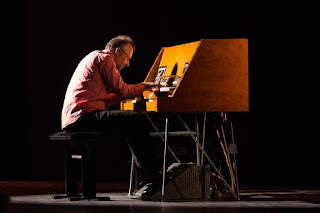 |
| Kirstjan Randalu and the varioola |
Reviewed by Robert Hugill on Mar 13 2016
Estonia's first electronic instrument given new life with four new pieces
 |
| Kirke Karja, Kirstjan Randalu and the varioola |
The National Library of Estonia is something of an historical icon itself, built in 1985 towards he Soviet era by an Estonia architect, Raine Karp, it is a monolithic stone building which references traditional Estonian design. The building includes a lecture theatre where the lecture recital took place. The varioola was an impressive looking instrument with fine cabinet work, which included two keyboards, numerous switches and pedal controls. Afterwards a chance to look at the instrument more closely revealed that the interior was a mass of circuitry and valves.
The idea for constructing the varioola arose in 1955 after hearing a German electronic instrument on the radio. Heino Pedusaar and Anatol Sügis did it as the result of a bet, Pedusaar being a musician and Sügis a technician. Sügis was present at the concert and explained that with electronic circuitry extremely difficult to get hold of in Soviet Estonia the instrument had been constructed out of parts left over and unwanted in factories. Once built it was used in popular music, theatre, films and plays but more recently it was in a museum and then in storage until the idea to restore it arose. Sügis has spent the last six months restoring the instrument, though it remains capricious so that the composers and performers not only had to learn new techniques, but had to cope with the instrument's uncertainty and the fact that Sügis had to be on hand to remedy any problems.
 |
| Anatol Sügis in conversation with Margo Kolar |
Next we heard an historic recording of the instrument made before it was restored, full of drones, deep tones and rumbling with unevenly placed high notes, building to something restless and rather disturbing.
The lecture part of the recital was given (in Estonia) by the composer Margo Kölar and the next piece was his Varioola variations for varioola and electronics, which used the electronics to incorporate what the composer described as 'memories about the unsettled nature of the re-revived varioola'. The work was played by Kirke Karja. It started with a basic short rhythmic motif (all timbre and tone and no pitch) over a slow moving low bass which developed quite a traditional feel with some hints of jazz bt with added atmospherics from the varioola which built into striking textures, with some references to 1980's rock music.
 |
| Mart Siimer |
The final work in the programme ReCycling by Marianna Liik brought both Kristjan Randalu and Kirke Karja back to the platform as the piece was written for two players, again with live electronics. The work was based around the overtone scale of the note D, and in it Liik explored ways applying an overtone scale to the varioola. Having two players meant a rich and complex multi-layered texture with more musical material and fewer atmospherics than some of the pieces, but always the musical figures were surrounded by a halo of extras. The piece varied between a somewhat static texture and a more dynamic, almost polyphonic one, returning finally to a static texture with increasing intensity. The closing pages took us into the realm of science fiction again, with what seemed to be the sound of a space ship taking off.
Whilst the varioola will never become a regular instrument in modern composers' amoury, this was a fascinating interaction between modern composers and an old, obsolete instrumental technology. It was perhaps significant that only one work seemed to use the instrument without any added electronics, but all the composers seemed to be fascinated by the complex historical layers with a sense of the instrument's unrestored self.
Elsewhere on this blog:
- Intelligent programming & fine singing: The Evening Hour, choir of Jesus College, Cambridge - CD review
- A story to tell: Johnny Herford & James Baillieu at the Wigmore Hall - concert review
- Whimsically gothic: Mahogany Opera Group in The Rattler - opera review
- Elegant Bach: Bach Collegium Japan in Mass in B Minor - concert review
- Not just charming background music: Handel at Vauxhall - CD review
- Blaze of youth indeed: Chad Hoopes, National Youth Orchestra of Great Britain and Kristjan Järvi - concert review
- Much to look forward to: Royal Opera's 2016-17 season preview
- Pulling focus: Katie Mitchell's new production of Donizetti's Lucia di Lammermoor - Opera review
- Stunning arias, telegraphic plot: Handel Arminio - CD review
- Cafe Zimmermann re-creation: Feinstein Ensemble in Bach, Handel & Telemann - concert review
- Engaging storytelling: Robin Tritschler in Berkeley and Britten - concert review
- Energetic and eclectic: Feinstein Ensemble in Bach's Mass in B Minor - concert review
- Home



.jpg)
.jpeg)






No comments:
Post a Comment